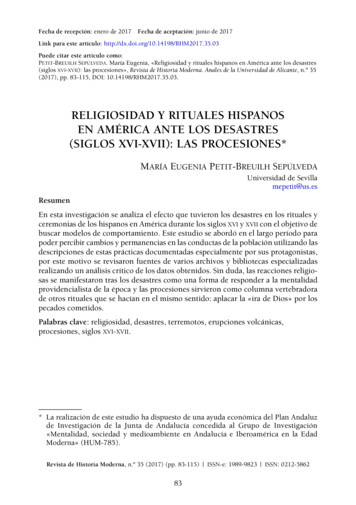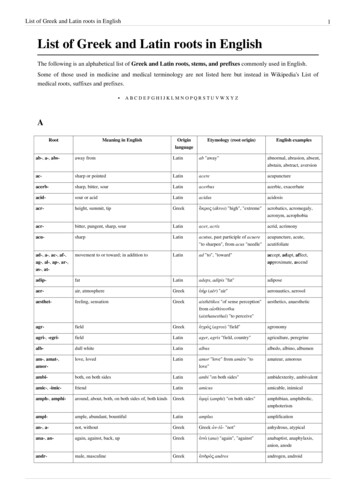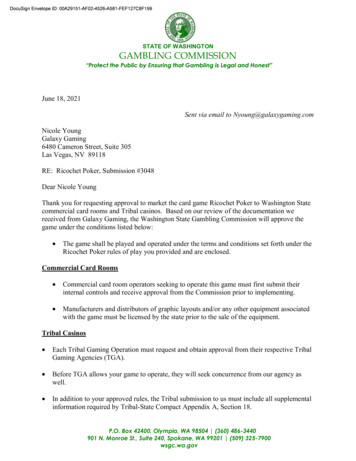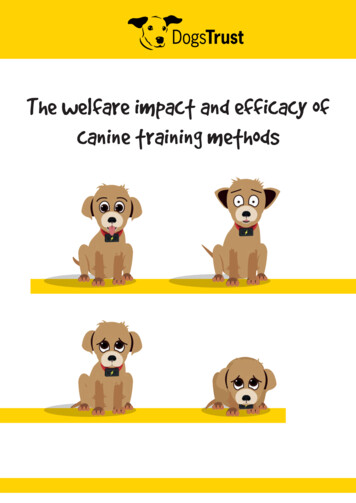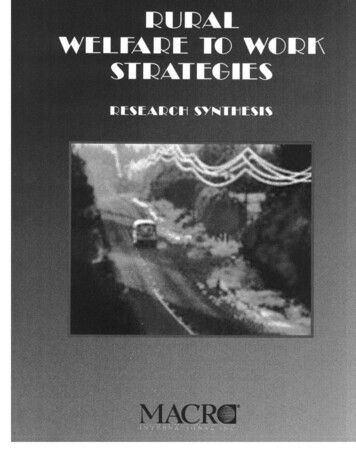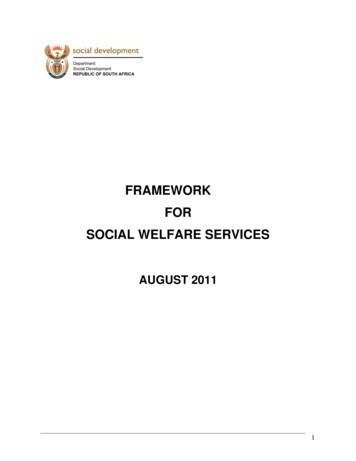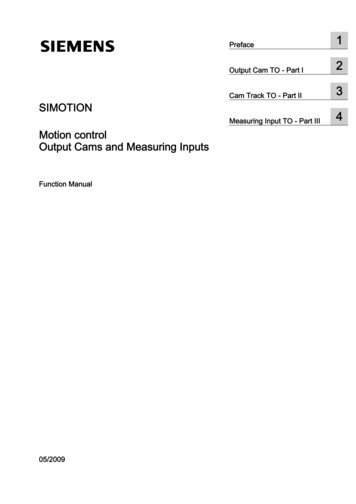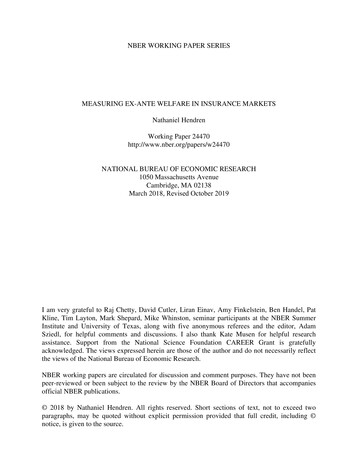
Transcription
NBER WORKING PAPER SERIESMEASURING EX-ANTE WELFARE IN INSURANCE MARKETSNathaniel HendrenWorking Paper 24470http://www.nber.org/papers/w24470NATIONAL BUREAU OF ECONOMIC RESEARCH1050 Massachusetts AvenueCambridge, MA 02138March 2018, Revised October 2019I am very grateful to Raj Chetty, David Cutler, Liran Einav, Amy Finkelstein, Ben Handel, PatKline, Tim Layton, Mark Shepard, Mike Whinston, seminar participants at the NBER SummerInstitute and University of Texas, along with five anonymous referees and the editor, AdamSziedl, for helpful comments and discussions. I also thank Kate Musen for helpful researchassistance. Support from the National Science Foundation CAREER Grant is gratefullyacknowledged. The views expressed herein are those of the author and do not necessarily reflectthe views of the National Bureau of Economic Research.NBER working papers are circulated for discussion and comment purposes. They have not beenpeer-reviewed or been subject to the review by the NBER Board of Directors that accompaniesofficial NBER publications. 2018 by Nathaniel Hendren. All rights reserved. Short sections of text, not to exceed twoparagraphs, may be quoted without explicit permission provided that full credit, including notice, is given to the source.
Measuring Ex-Ante Welfare in Insurance MarketsNathaniel HendrenNBER Working Paper No. 24470March 2018, Revised October 2019JEL No. H0,I11,I3ABSTRACTThe willingness to pay for insurance captures the value of insurance against only the risk thatremains when choices are observed. This paper develops tools to measure the ex-ante expectedutility impact of insurance subsidies and mandates when choices are observed after someinsurable information is revealed. The approach retains the transparency of using reduced-formwillingness to pay and cost curves, but it adds one additional sufficient statistic: the difference inmarginal utilities between insured and uninsured. I provide an approach to estimate this statisticthat uses only reduced-form willingness to pay and cost curves, combined with either a measureof risk aversion. I compare the approach to structural approaches that require fully specifying thechoice environment and information sets of individuals. I apply the approach using existingwillingness to pay and cost curve estimates from the low-income health insurance exchange inMassachusetts. Ex-ante optimal insurance prices are roughly 30% lower than prices thatmaximize market surplus. While mandates would increase deadweight loss, the results suggestthey would actually increase ex-ante expected utility.Nathaniel HendrenHarvard UniversityDepartment of EconomicsLittauer Center Room 235Cambridge, MA 02138and NBERnhendren@gmail.com
Measuring Ex-Ante Welfare in Insurance MarketsNathaniel Hendren October, 2019AbstractThe willingness to pay for insurance captures the value of insurance against onlythe risk that remains when choices are observed. This paper develops tools to measurethe ex-ante expected utility impact of insurance subsidies and mandates when choicesare observed after some insurable information is revealed. The approach retains thetransparency of using reduced-form willingness to pay and cost curves, but it adds oneadditional sufficient statistic: the difference in marginal utilities between insured anduninsured. I provide an approach to estimate this statistic that uses only reduced-formwillingness to pay and cost curves, combined with either a measure of risk aversion. Icompare the approach to structural approaches that require fully specifying the choiceenvironment and information sets of individuals. I apply the approach using existingwillingness to pay and cost curve estimates from the low-income health insurance exchange in Massachusetts. Ex-ante optimal insurance prices are roughly 30% lower thanprices that maximize market surplus. While mandates would increase deadweight loss,the results suggest they would actually increase ex-ante expected utility.1IntroductionRevealed preference theory is often used as a tool for measuring the welfare impact of government policies. Many recent applications use price variation to estimate the willingnessto pay for insurance (Einav et al. (2010); Hackmann et al. (2015); Finkelstein et al. (2019);Panhans (2018)). Comparing willingness to pay to the costs individuals impose on insurersprovides a measure of market surplus. This surplus potentially provides guidance on optimal Harvard University, nhendren@fas.harvard.edu. I am very grateful to Raj Chetty, David Cutler, LiranEinav, Amy Finkelstein, Ben Handel, Pat Kline, Tim Layton, Mark Shepard, Mike Whinston, seminarparticipants at the NBER Summer Institute and University of Texas, along with five anonymous referees andthe editor, Adam Sziedl, for helpful comments and discussions. I also thank Kate Musen for helpful researchassistance. Support from the National Science Foundation CAREER Grant is gratefully acknowledged.1
insurance subsidies and mandates (Feldman and Dowd (1982)). If individuals are not willingto pay the costs they impose on the insurer, then greater subsidies or mandates will lowermarket surplus. From this perspective, subsidies and mandates would reduce welfare and besocially undesirable.Measures of willingness to pay are generally a gold standard input into welfare analysis.But, in insurance settings they can be misleading. Insurance obtains its value by insuringthe realization of risk. Often, individuals make insurance choices after learning some information about their risk. It is well-known that this can lead to adverse selection. What is lessappreciated is that observed willingness to pay will not capture value of insuring against thislearned information.1 As a result, welfare conclusions based on market surplus can vary withthe information that individuals have when the economist happens to observes choices. Policies that maximize observed market surplus will not generally maximize canonical measuresof expected utility.To see this, consider the decision to buy health insurance coverage for next year. Supposesome people have learned they need to undergo a costly medical procedure next year. Theirwillingness to pay will include the value of covering this known cost plus the value of insuringother future unknown costs. Market surplus - defined as the difference between willingnessto pay and costs - will equal the value of insuring their unknown costs. But, it will notinclude any insurance value from covering the known costly medical procedure. This riskhas already been realized when willingness to pay is observed.Now, consider an economist seeking to measure the welfare impact of extending healthinsurance coverage next year to everyone through a mandate or large subsidy. The marketsurplus or deadweight loss generated from the policy will depend on how much people havelearned about their health costs at the time the economist happened to measure willingnessto pay. Existing literature (and introspection) suggests that individuals know more aboutexpected costs and events in the near future (e.g. Finkelstein et al. (2005); Hendren (2013,2017); Cabral (2017)). If willingness to pay had been measured earlier, market surpluscould be larger because it would include the value of insuring against the costly medicalprocedure. This occurs even though the economic allocation generated by a mandate does notvary depending on when the economist measures willingness to pay. In contrast, traditionalnotions of the expected utility impact of a mandate would not depend on when the economisthappens to measure willingness to pay. Expected utility provides a consistent framework foridentifying optimal insurance policies that depends on economic allocations.The goal of this paper is to enable researchers to evaluate the impact of insurance market1This idea is related to Hirshleifer (1971), who shows that individuals may wish to insure against therealization of information.2
policies on expected utility, where the expectation is taken prior to when insurance choicesare made. Traditional methods to estimating ex-ante expected utility would estimate astructural model. Among other things, the model would specify what individuals knowwhen choosing whether to buy an insurance plan. It would then be estimated using observedinsurance choices along with data on the realized utility-relevant outcomes, such as healthand consumption.2 Intuitively, if one has a structural model and knows what informationhas been realized when individuals choose their insurance policies, one can infer the value ofinsuring the risk that has been revealed before making those choices. But, in practice it isespecially difficult to observe individuals’ information sets when they make choices. This isespecially true in insurance markets that suffer from adverse selection driven by asymmetricinformation.This paper develops a new approach to measure the expected utility impact of insurancemarket policies. The approach does not require specifying structural assumptions aboutindividuals’ information sets at the time of choice, nor does it require specifying a utilityfunction or observing the distribution of utility-relevant outcomes in the economy. Instead,I exploit the information contained in reduced-form willingness to pay and cost curves asoutlined by Einav et al. (2010). In this environment, I characterize the minimal additionalsufficient statistics required to measure the expected utility of subsidies and mandates.The first main result of the paper shows that one can measure ex-ante expected utilityusing one additional sufficient statistic: the difference in marginal utilities of income forthose who do versus do not buy insurance. This measures how much individuals wish tomove money to the state of the world in which they buy insurance. In the example above,it reflects the desire to insure the costly medical procedure. These individuals have a higherdemand for insurance, and have a higher marginal utility of income.In general, it is difficult to observe or measure differences in marginal utilities of incomebetween those who do versus do not purchase insurance. The second result of the paperaddresses this by providing a benchmark estimation method that uses only the reduced-formwillingness to pay and cost curves combined with a measure of risk aversion. This additionalrisk aversion parameter can be assumed, or it can be inferred from the observed markupindividuals are willing to pay for insurance, combined with the extent to which insurancereduces the variance in out of pocket expenditures.This second main result follows two steps. First, building on the literature on optimalunemployment insurance (Baily (1978); Chetty (2006)), I use measures of consumption differences between insured and uninsured, combined with risk aversion, to measure differencesin marginal utilities. Second, because consumption is seldom observed, I provide conditions2For example, see Handel et al. (2015) or Section IV of Einav et al. (2016).3
under which one can exploit the information in the reduced-form willingness to pay curvefor insurance instead of consumption.I apply the framework to study the optimal subsidies and mandates for low-income healthinsurance in Massachusetts. Finkelstein et al. (2019) use price discontinuities as a functionof income to estimate willingness to pay and cost curves for those with incomes near 150%of the federal poverty level (FPL). Their results show that an unsubsidized private insurancemarket would unravel.3 Without subsidies, the market would not exist. I use the approachto ask what types of insurance subsidies or mandates individuals would want in the MAhealth insurance exchange if they had been asked prior to learning anything about whetherthey would actually be in the MA health insurance exchange and eligible for the subsidiesin question. In this sense, it evaluates subsidies and mandates using an ex-ante notion ofwelfare that is both ex-ante expected utility and ex-post utilitarian social welfare.4I use the framework to provide guidance on both budget neutral and non-budget neutralpolicies in this environment. Budget neutral policies ask whether the government shouldprovide additional subsidies financed by increased prices/penalties for those not purchasinginsurance – this is the canonical set of policies studied in Einav et al. (2010). To set thestage, traditional market surplus is maximized when insurance premiums are 1,581 and 41%of those eligible for insurance choose to purchase. In contrast, I find that a 30% lower priceof 1,117 with 54% of the market insured maximizes ex-ante welfare. Those who are inducedto purchase insurance from by lowering prices from 1,581 to 1,117 are not willing to paythe cost they impose on the insurance company. However, from behind a veil of ignorancethey value the ability to purchase insurance at lower prices if they end up having a highdemand for insurance.One can also evaluate the welfare impact of a full insurance mandate (with sufficientlylarge penalties to generate full coverage). Such a policy would lower market surplus by 45 –on average, those in the economy are not willing to pay the cost they impose on the insurancecompany. However, from behind a veil of ignorance individuals would be willing to pay 169to have a full insurance mandate. Indeed, the willingness to pay for a mandate remainspositive for a wide range of plausible risk aversion parameters (e.g. with coefficients ofrelative risk aversion above 1.7). This illustrates how an ex-ante welfare perspective can leadto dramatically different normative conclusions about the desirability of commonly debated3This unraveling is due to a combination of adverse selection and uncompensated care externalities.This welfare perspective provides a natural benchmark as it does not make a normative distinctionbetween redistribution and insurance (e.g. Harsanyi (1978)). However, the approach does not require autilitarian perspective, nor does it require measuring expected utility behind a complete veil of ignorance.One can conduct the analysis conditional on any observable subgroup, X x (e.g. old vs. young, malevs. female, with vs. without chronic health conditions, etc.). Doing so requires willingness to pay and costcurves for each subgroup.44
insurance policies.In practice, insurance subsidies in Massachusetts (as in many cases) were not paid bypenalties targeting the uninsured in the market; rather they were paid by general governmentrevenue and taxpayers more generally. To capture this, I estimate the marginal value of publicfunds (MVPF) of additional insurance subsidies. the MVPF for an additional insurancesubsidy is the individual’s willingness to pay for it divided by its net cost to the government(Hendren (2016)). Comparisons of MVPFs across policies correspond to statements about thevalue of redistributing across different subpopulations. For example, comparing the MVPFof insurance subsidies to low-income tax credits allows one to ask whether individuals at150% would prefer additional insurance subsidies or prefer a tax subsidy.The results suggest that when prices are set so that 30% of the market has insurance,individuals are willing to pay roughly 1.2 times the marginal cost they impose on the insurerto lower insurance prices. This implies an MVPF of 1.2, which is similar to the range ofMVPF estimates for tax credits to low-income populations studied in Hendren and SprungKeyser (2019), which are around 0.9-1.3. However, those benefiting from the insurancesubsidies have a higher marginal utility of income than those benefiting from a tax cut.From behind the veil of ignorance, the results suggest that individuals would be willing topay 1.8 times the cost they impose on the insurer to lower insurance prices. Put differently,individuals would prefer from behind a veil of ignorance to spend money lowering insuranceprices for those at 150% of FPL instead of providing them with a tax cut. In short, theability to distinguish between ex-ante expected utility and market surplus provides differentguidance on important questions of optimal insurance market policies.Traditional approaches to measuring ex-ante expected utility would estimate a structuralmodel. This would involve fully specifying not only a utility function but also the information set of individuals at the time they make insurance choices. The economic primitivesestimated from the model would then provide an ex-ante measure of welfare. In contrast, thesufficient statistics approach developed here does not require researchers to know the exactutility function, nor does it require knowledge of individuals’ information sets when theymake insurance choices. Information sets can be particularly tough to specify in settings ofadverse selection where even insurers have trouble worrying about the unobserved knowledgeof the applicant pool. In addition, the approach developed here can be implemented usingaggregate data from insurers or governments on the cost and fraction of the market purchasing insurance at different prices, as opposed to requiring observations on individual-leveldata that would be required to estimate the structural model.To further understand the relationship to the structural approach, I develop a fully specified structural model with moral hazard and adverse selection that can fully match the5
reduced form willingness to pay and cost curves in the Finkelstein et al. (2019) environment.The model builds upon the approach in Handel et al. (2015) but augments it with a moralhazard structure developed in Einav et al. (2013a). I use the model to verify that the approach developed here recovers the true ex-ante welfare quite well. However, the benchmarkimplementation relies on two key assumptions that may be violated in some applications.I use the structural environment to understand the impact of violating these assumptions,and validate proposed modifications to my approach that help recover ex-ante welfare whenthe key assumptions are violated.First, using the demand curve to proxy for differences in consumption requires that thereare no differences in liquidity or income between the insured and uninsured. While this isperhaps a natural assumption in the context subsidies to a given income level (i.e. 150%FPL in MA), it is quite restrictive in many other settings where income differences may bea key driver of willingness to pay for insurance. In these cases, I show that one can recoverex-ante welfare using my approach if one can observe the average consumption of the insuredand uninsured in the market.Second, the benchmark implementation requires that individuals have common coefficients of relative risk aversion. However, previous literature has highlighted a role of preference heterogeneity as an important driver of insurance demand. In this case, I show thatthe ideal measure of risk aversion is the “ex-ante” risk aversion that governs the markup thatindividuals would be willing to pay from behind a veil of ignorance for a product that helpslower their insurance prices. I show that the common structural models with preferenceheterogeneity raise the potential concern that the “ex-ante” risk aversion coefficient mightdiffer from the average risk aversion of individuals expressed over coverage choices in themarket. This means that, in practice, researchers will want to study the robustness of theresults to a range of risk aversion parameters with the knowledge that the ideal risk aversionis the one that governs the hypothetical ex-ante willingness to pay for a financial productthat helps reduce the price of insurance.The ideas developed in this paper readily extend to other settings where individualsmeasure the value of insurance using principles of revealed preference. For example, oftenbehavioral responses such as labor supply changes are used to measure the value of socialinsurance. The more individuals are willing to adjust their labor supply to become eligible forinsurance, the more they value the insurance (e.g. Keane and Moffitt (1998); Gallen (2014);Dague (2014)). Such an approach captures the value of insurance against only the risk thatis revealed after they adjust their behavior.5 Similarly, other papers infer willingness to5Indeed, Gallen (2014) shows many individuals who respond have particularly costly health conditions.The measure of willingness to pay in Gallen (2014) will miss the value of insurance against those health6
pay for social insurance from changes in consumption around a shock (e.g. Gruber (1997);Meyer and Mok (2013)). When information is revealed over time, the consumption changemay vary depending on the time horizon used (Hendren (2017)). In the extreme, theremay be no change around the event (e.g. smooth consumption around onset of disability orretirement). Consumption should change when information about the event is revealed, notwhen the event occurs. The methods in this paper can be applied to conceptualize whichconsumption difference is most appropriate for the desired notion of expected utility.The rest of this paper proceeds as follows. Section 2 provides a stylized example thatdevelops the intuition for the approach. Section 3 provides the general modeling frameworkand introduces the application from from Finkelstein et al. (2019), who study health insurance subsidies for low-income adults in Massachusetts. Section 4 uses the model to definenotions of ex-ante welfare and provides the general result that the ex-ante willingness topay for insurance requires the difference in marginal utilities between insured and uninsured.Section 5 provides a benchmark method to estimate this difference in marginal utilities usingwillingness to pay and cost curves combined with a measure of risk aversion. Section 6 implements this approach using the estimates from MA. Section 7 develops a structural modeland assesses the extent to which the proposed approach matches the structural notions ofex-ante welfare. Section 8 uses the model to assess the potential impact of violations of theimplementation assumptions outlined in Section 5. Section 9 concludes.2Stylized ExampleI begin with a stylized example to illustrate the distinction between market surplus and exante expected utility and to summarize the paper’s main results. Suppose individuals have 30 dollars but face a risk of losing m dollars, where m is uniformly distributed between 0and 10. Let DEx ante denote the willingness to pay or “demand” for a full insurance contractthat is measured prior to individuals learning anything about their particular realization ofm. This solves (1)u 30 DEx ante E [u (30 m)]R 101where E [u (30 m)] 10u (30 m) dm is the expected utility if uninsured.0Suppose individuals have a utility function with a constant coefficient of relative risk1aversion of 3 (i.e. u (c) 1 σc1 σ and σ 3). This implies individuals are willing to payDEx ante 5.50 for an insurance policy that fully compensates for their loss. The cost thispolicy would be E [m] 5. Full insurance generates a market surplus of 0.50.conditions.7
Figure 1: Example Willingness to Pay and Cost CurvesB. After Information Revealed1010A. Before Information Revealed6* 145617 6"# %#&' &()*%(& )#, #)-.#/- ')01-&88! "# %&'( ) * "# %&'( , - ) ./0.* 12244! 10.2.4.6Fraction Insured.81 2" ) .001 2" ) 301! 1.2.4.6Fraction Insured.81Figure 1A draws the demand and cost curves that would be revealed through randomvariation in prices in this environment, as formalized in Einav et al. (2010). The horizontalaxis enumerates the population in descending order of their willingness to pay for insurance,indexed by s [0, 1]. The vertical axis reflects prices, costs, and willingness to pay in themarket. Each individual is willing to pay 5.50 for insurance, reflected in the horizontaldemand curve of D (s) 5.50. In addition, each person imposes an expected cost of 5on the insurance company, which generates a flat cost curve of C (s) 5. If a competitivemarket were to open up in this setting, one would expect everyone to purchase insuranceat a price of 5, depicted by the vertical line at sCE 1. This allocation would generateW Ex Ante 0.50 of welfare, as reflected by the market surplus defined as the integralbetween demand and cost curve.What happens if individuals learn about their costs before they choose whether to purchase insurance? For simplicity, consider the extreme case that individuals have fully learnedtheir cost, m. Willingness to pay will equal individuals’ known costs, D (s) m (s). Thosewho learn they will lose 10 will be willing to pay 10 for “insurance” against their loss; individuals who learn they will lose 0 will be willing to pay nothing. The uniform distributionof risks generates a linear demand curve falling from 10 at s 0 to 0 at s 1. The costimposed on the insurer by the type s, C (s), will equal their willingness to pay of D (s), asshown in Figure 1B.If an insurer were to try to sell insurance, they would need to set prices to cover theaverage cost of those who purchase insurance. Let AC (s) E [C (S) S s] denote the8
average cost of those with willingness to pay above D (s) .6 This average cost lies everywhereabove the demand curve. Since no one is willing to pay the pooled cost of those with higherwillingness to pay, the market would fully unravel. The unique competitive equilibriumwould involve no one obtaining any insurance, sCE 0.What is the welfare cost of this market unraveling? From a market surplus perspective,there is no welfare loss. There are no valuable foregone trades that can take place at the timeinsurance choices are made. This reflects an extreme case of a more general phenomenonidentified in Hirshleifer (1971). The market demand curve does not capture the value ofinsurance against the portion of risk that has already been realized at the time insurancechoices are made. This means that policies that maximize market surplus may not maximizeexpected utility if one measures expected utility prior to when all information about m isrevealed to the individuals.How can one recover measures of ex-ante welfare? The traditional approach to measuringDEx Ante and the value of other insurance market policies would require the econometricianto specify economic primitives, such as a utility function and an assumption about individuals’ information sets at the time of choice. It would then also involve measuring thedistribution of outcomes that enter the utility function, such as consumption, and use thisinformation to infer the ex-ante value of insurance from the model. Intuitively, if one knowsthe utility function, u, and the cross-sectional distribution of consumption (30 m in theexample above), then one can use this information to compute DEx Ante in equation (1).For recent implementations of this approach, see Handel et al. (2015), Section IV of Einavet al. (2016), or Finkelstein et al. (2016).The goal of this paper is to measure the expected utility impact of insurance marketpolicies, such as optimal subsidies and mandates, without knowledge of the full distributionof structural primitives in the economy (e.g. utilities, outcomes, and beliefs). Rather, thepaper builds on the reduced form framework that uses price variation to identify demandand cost curves in the economy.The core idea can be seen in the following example of a budget-neutral expansion ofthe market. To expand the size of the insurance market in a budget neutral way, oneneeds to subsidize insurance purchase and tax those who do not purchase insurance. Thesetransfers between insured and uninsured do not affect market surplus. The market surplusfrom expanding the size of the insurance market from s to s ds is given by D (s) C (s).However, from an ex-ante perspective, these transfers affect welfare if the marginal utility ofincome is different for the insured versus uninsured.6Throughout, we will let S denote the random variable corresponding to different types and s denote anumber corresponding to the size of the insurance market.9
The first main result shows that if individuals had been asked their willingness to pay tohave a large insurance market prior to learning their risk type, they would have been willingto pay not just D (s) but an additional amount EA (s), whereEA (s) s (1 s) ( D′ (s))E [uc Ins] E [uc U nins]E [uc ](2)The first term, s (1 s) D′ (s) characterizes the size of the transfer from uninsured to inc U nins],sured when expanding the size of the insurance market. The second term, E[uc Ins] E[uE[uc ]captures the value of this transfer using the difference in the marginal utilities of income between the insured and uninsured. If the insured have higher (lower) marginal utilities ofincome, then expanding the size of the insurance market by lowering the prices paid by theinsured has ex-ante value beyond what is captured in traditional measures of market surplus.Constructing EA (s) in equation (2) requires knowledge of the difference in marginalutilities between insured and uninsured. Such differences are not directly observed. Thesecond main result of the paper shows that if consumption levels are the only determinantof marginal utilities (as would be the case in canonical models of insurance like the modelhere or in more general models with additive separable utility over consumption), then onecan approximate difference in marginal utilities using the difference in consumption betweeninsured and uninsured, multiplied by a coefficient of risk aversion. However consumption israrely observed in practice. Therefore, in a final step I show that if there are not systematicdifferences in income or liquidity between insured and uninsured, then one can actually proxyconsumption differences using the demand curve. In the end, this yields conditions underwhich the difference in marginal utilities can b
insurance - this is the canonical set of policies studied in Einav et al. (2010). To set the stage, traditional market surplus is maximized when insurance premiums are 1,581 and 41% of those eligible for insurance choose to purchase. In contrast, I find that a 30% lower price of 1,117 with 54% of the market insured maximizes ex-ante welfare.

